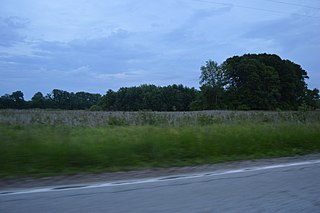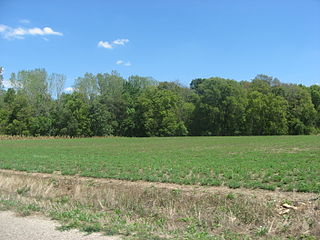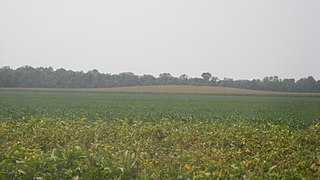
The Mound House is an archeological site located in Greene County, Illinois in the Illinois River floodplain. The site is a multicomponent site; however, the mounds were constructed during the Middle Woodland and are associated with the Havana Hopewell culture. The mound center has two identified mounds.

The Kamp Mound Site is a prehistoric mound and village site located along the Illinois River and Illinois Route 100 north of Kampsville, Illinois. The Hopewellian site includes seven mounds dating from 100 B.C. - 450 A.D. and a village site dating from 450-700 A.D. The Havana Hopewell culture used the complex as a ceremonial and burial site. Archaeologists have also proposed that the site served as a regional trade center for the Hopewellian exchange system. The seven mounds at the site, which were originally part of a group of ten, include some of Illinois' largest mounds. In addition, large amounts of shell and animal bone fragments have been recovered from the site.

The Toolesboro Mound Group, a National Historic Landmark, is a group of Havana Hopewell culture earthworks on the north bank of the Iowa River near its discharge into the Mississippi. The mounds are owned and displayed to the public by the State Historical Society of Iowa. The mound group is located east of Wapello, Iowa, near the unincorporated community of Toolesboro.

Clear Lake Site is an archaeological site located in Sand Ridge State Park 6.5 miles (10.5 km) from Manito, Illinois. The site was occupied for the majority of the period from 500 B.C. to 1500 A.D.; cultures which have occupied the site include the Early Woodland, Havana Hopewell, and Mississippian. The site consists of a village area and two burial mounds. University of Chicago archaeologists conducted the first excavations at the site in 1932. Significant further excavations were conducted by George and Ethel Schoenbeck of the Peoria Academy of Science; the couple recovered 24,000 pottery shards from the site which represent every pottery type found in Central Illinois. The Illinois State Museum, which received all artifacts recovered by the Schoenbecks, conducted its own excavations at the site in the 1950s.

The Stoner Site is a substantial archaeological site in the far eastern portion of the U.S. state of Illinois. Discovered during the Great Depression, the site has produced large numbers of artifacts from a prehistoric village that was once located there, and archaeological investigations have shown it to be one of the area's most important archaeological sites for the Allison-Lamotte culture. After more than a decade of fruitful research and predictions of potentially rich results from future work, it has been designated a historic site.

The Sinnissippi Mounds are a Havana Hopewell culture burial mound grouping located in the city of Sterling, Illinois, United States.

The Kincaid Mounds Historic Site c. 1050–1400 CE, is a Mississippian culture archaeological site located at the southern tip of present-day U.S. state of Illinois. Kincaid Mounds has been notable for both its significant role in native North American prehistory and for the central role the site has played in the development of modern archaeological techniques. The site had at least 11 substructure platform mounds. Artifacts from the settlement link its major habitation and the construction of the mounds to the Mississippian period, but it was also occupied earlier during the Late Woodland period. The site was declared a National Historic Landmark in 1964 for its significance as a major Native American mound center and prehistoric trading post along the Ohio River.

Norton Mound Group,, is a prehistoric Goodall Focus mounds site near Grand Rapids, Michigan.

This is a list of the National Register of Historic Places listings in Jersey County, Illinois.

The Mann Site is a Crab Orchard culture site located off Indian Mound Road in Mount Vernon, Posey County, Indiana. It was placed on the National Historic Register on October 1, 1974. Exotic ceramics and other artifacts found at the site reflect contact with Ohio Hopewell and Swift Creek culture people of the Georgia Piedmont and Gulf Coastal Plain.

The Bynum Mound and Village Site (22CS501) is a Middle Woodland period archaeological site located near Houston in Chickasaw County, Mississippi. The complex of six burial mounds was in use during the Miller 1 and Miller 2 phases of the Miller culture and was built between 100 BC and 100 AD. It was listed on the National Register of Historic Places in 1989 as part of the Natchez Trace Parkway at milepost 232.4.

The Beam Farm Woodland Archaeological District is a group of archaeological sites in the southwestern part of the U.S. state of Ohio. Located at 3983 Stone Road near the village of Sabina in Clinton County, the district is composed of one Native American mound and two other archaeological sites spread out over an area of 2 acres (0.81 ha). Known as the Beam Farm Mound and the Beam Sites 9 and 12, the sites that compose the district have yielded artifacts from the Adena culture and the Hopewell tradition, both of which inhabited southwestern Ohio during the Woodland period. Because both the Adena and the Hopewell lived around the mound, and because both cultures built mounds, the identity of the people who constructed the Beam Farm Mound cannot be established; all that can be known with reasonable certainty is that it was raised during the early or middle portion of the Woodland period, or between 800 BC and AD 500.

The Hubele Mounds and Village Site are an archaeological site in the southeastern part of the U.S. state of Illinois. Located near the community of Maunie in White County, the site has received recognition from the federal government because of its archaeological value. Due to the lack of recent excavations, the site's dates of habitation are debated, ranging from 400 BC in some estimates to AD 1000 in others, but all agree on the site's significance to understanding the prehistory of the region.

The Cleiman Mound and Village Site is a prehistoric archaeological site located near the Mississippi River in Jackson County, Illinois. The site includes an intact burial mound and the remains of a village site. The village was inhabited by a number of prehistoric cultures during the Archaic, Woodland, and Mississippian periods; settlement at the site began prior to 400 B.C. and lasted through 1300 A.D. The mound was built during the Middle Woodland Period by Hopewellian peoples and is likely the only Hopewell mound in the Mississippi Valley in Southern Illinois.

The Carrier Mills Archaeological District is a group of prehistoric archaeological sites located along the Saline River south of Carrier Mills, Illinois. The sites were inhabited over the period from 2500 B.C. to 700 A.D. The oldest three sites date from the Late Archaic period, which encompassed the first 1500 years of occupation at the district; these sites include two small campsites and a larger base camp. Several sites were inhabited during the Early Woodland period, which lasted until 500 B.C.; these sites are distinguished by fragments of pottery, which was developed during this period. The Early Woodland period sites are likely to have been a part of the Crab Orchard culture, a local subtype of the Hopewell tradition. A number of sites date from the Middle Woodland Period, which spanned from 300 B.C. to 500 A.D.; these sites appear to have adopted the technology, but not the traditions, of the Hopewell culture. A single projectile point from the Late Woodland period has also been recovered from the site.

The Wilson Mounds and Village Site is a prehistoric archaeological site located in and around the Marshall Ferry Cemetery in Rising Sun, White County, Illinois. The site includes twelve burial mounds and a village site. The site was inhabited by Hopewell peoples from approximately 400 B.C. to 400 A.D. Excavations at the site began in the 1940s; the first formal investigations were conducted the following decade by the Illinois State Museum and the University of Chicago. The site was part of a trade network which spanned much of the eastern United States, as resources from as far away as North Carolina and the Lake Superior region have been found at the site. Two different skeletal types have been recovered from the site, indicating the presence of multiple cultures at the village. The site also includes a prehistoric cemetery in addition to burial mounds, suggesting that burials were organized based on social status.

Duncan Farm is an archaeological site located on a farmstead south of Illinois Route 100 in Jersey County, Illinois, near the city of Grafton. The site, which dates from the Woodland period, includes two burial mounds and a habitation site. The site was part of the Hopewell exchange system in Illinois and is the closest neighboring village site to the Golden Eagle regional transaction center, a major trade and social hub in the system. Archaeologists have suggested that the site is a local transaction center in the Golden Eagle site's region due to its two large mounds, which are roughly 200 feet (61 m) long and 100 feet (30 m) wide each. In addition, the site is archaeologically significant due to its distinctive stratification, which allows its artifacts to be easily dated.

The Golden Eagle-Toppmeyer Site is a pre-Columbian archaeological site located near the confluence of the Illinois and Mississippi Rivers in Calhoun County, Illinois. The site is associated with the Havana Hopewell culture and has two main components: the Golden Eagle earthwork and the Toppmeyer habitation site. The earthwork, which dates from the Middle Woodland period, is the only geometric earthwork from the period in the central Mississippi River valley. Two mounds are incorporated in the rounded earthwork; one is located at the center, and one is located at a gap which has been called the "entrance" to the earthwork. The Toppmeyer habitation site, which overlaps the western edge of the earthwork, dates from the Late Woodland period. The overall site was likely a regional transaction center at which extensive trade and cultural exchange among Hopewell people in the Illinois River valley took place.

The Naples Archeological District is an archaeological district located on the east bank of the Illinois River at Naples, Illinois. The district includes sixteen archaeological sites which were primarily occupied during the Woodland period. The area was most active during the Middle Woodland period, when it served as an important trade site in the Hopewell exchange system. Over a dozen mounds are included in the district; these mounds mainly served as burial sites, though a number were used to store refuse. The area also includes several large village sites, as Naples was a habitation site in addition to a trade center.

The Ogden-Fettie Site is a prehistoric mound site located south of Lewistown in Fulton County, Illinois. The site was built during the Woodland period and is associated with the Havana Hopewell culture; it dates from roughly 100 B.C. to 400 A.D. The site consists of thirty-five mounds arranged in a crescent-shaped enclosure; the principal mound, located near the center, is 15 feet (4.6 m) high. A village site is located near the principal mound; it and four of the smaller mounds form a pentagonal-shaped enclosure. While such enclosures were common among the Ohio Hopewell, the Ogden-Fettie Site has the only known one west of Ohio.



















